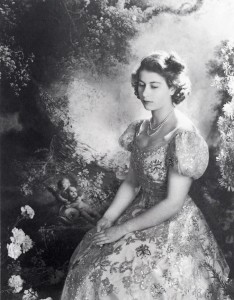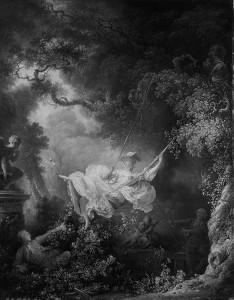When a friend offered me a slightly worn copy of Cecil Beaton’s Photography (1951), a series of autobiographical anecdotes compiled by one of the twentieth-century’s foremost society photographers, I did not have to think twice about accepting it, for I had always been intrigued by his elaborately staged portraits. In the late 1930s and early ‘40s Beaton seemed to delight in “historical artifice,” posing members of the royal family against old master paintings or within period interiors. In early March 1945, he was summoned to Buckingham Palace to take an official photograph of George VI’s daughter, Princess Elizabeth, intended to mark her attaining the age of majority. In a half dozen varieties reproduced in books and magazines, she appears at three-quarter length, firmly seated and facing left, ensconced in lush foliage. She is clothed in a low-necked, short-sleeved gown of pink crinoline speckled with sequined floral sprays and butterflies, her mother’s Hartnell hand-me-down during a time of economic austerity. Brown hair strangely cresting to the side and ruddy hands heavily clasped in the lap, the shy teenager looks directly at the camera and smiles broadly in salutation or lowers her visage in romantic introspection. She is flanked by two thin sprays of carnations and backed by a partial reproduction of Jean-Honoré Fragonard’s The Hazards of the Swing (1767). Yet the illusion of a fairy princess dwelling amid magical trees and birds seems a bit contrived even for this era.
By juxtaposing a very alive princess with a painterly forest, Beaton may have imagined that he was elevating his technique by allusion to an eighteenth-century French masterwork and securing for his sitter the illusion of youthful innocence and beauty. However, there are hazards to quoting old masters, the most obvious being that the content of the backdrop may be incongruous with the values of the sitter.
From the moment Fragonard showed historical narratives at the Salon (or art exhibition of the French Académie Royale in Paris) in 1765, he was hailed as an official talent capable of reinvigorating grand format history painting for the edification of the public. Soon after, however, Fragonard abandoned an academic career and the historical genre for a private existence making rococo decorative panels for the haute bourgeoisie. A wealthy Intendant des finances (tax collector) for the clergy, the baron de Saint-Julien had conceived The Swing as a titillating fantasy wherein his mistress would be represented on the ropes being pushed from behind by her placid husband and regarded from below by her enthralled lover. The artist was accustomed to making precise studies of landscape, but whenever he came to adapt these to decorative vignettes like this one, his imagination took over. For example, a massive, gnarled, yet still eminently virile oak frames the right and upper sides of the canvas, its billowing branches melding with the blue-green bushes and trees beyond. The attitudes of the human inhabitants are no less exaggerated. The young mistress wears a luxurious robe à la française of pale pink silk trimmed at the bodice and sleeves with frothy waves of bows and lace, the amplitude of which is tested by the husband pulling her ever higher into the air. As the demimondaine floats upward and over a rose bramble, she raises a leg in order to discharge a miniature shoe, a signal to her lover that incidentally provides him with a tantalizing view up her skirt. Reclining against a cylindrical plinth carved with a nude chase scene and topped with Etienne-Maurice Falconet’s 1757 marble sculpture of Cupid invoking silence, the rascal is clothed in a simple pale gray suit and gazes upward adoringly. He raises his tricorn hat in an effort to brush her dangling leg. When legal and moral strictures have fallen away, burgeoning nature steps in to abet the sexual impulse.
To be sure, Beaton did his best to neutralize any chance that the sensational content of Fragonard’s The Swing would be associated with the physical person of Princess Elizabeth. As Roy Strong has observed, Beaton charged a photographic firm in Ealing to provide him with a single enlarged portion of the French canvas printed in reverse. Nevertheless, wartime technology had its limitations, and the supporting ropes and billowing dress of the air-born lady remained partly visible in the upper left, requiring a (painted?) overlay of parallel hatchings. Joint recognition of a famous work from the art historical canon and an official representative of the British government results in an attempt to relate the two. Did Princess Elizabeth own Fragonard’s painting or admire the rococo style and, if not, why did she find this imagery appropriate? And joint recollection of the painting’s mistress on a swing and the photograph’s princess on a stool results in an attempt to reconcile their divergent identities and interests. Yet the two women are hardly in sympathy: the princess’s decorous and genial presence transforms the space from one of amorous dalliance to one of youthful purpose and imagination. Personal desires are upstaged by official obligations, the thick ropes re-cast as supports for a tottering but still admired tree: the House of Windsor.
Beaton’s approach was typical for press photographs and studio films of the period, offering aristocratic and bourgeois clients the illusion of graciousness and congeniality and consumers relief from poverty and warfare. Equipped with large and medium format cameras capable of registering optimal figural detail and tonal subtlety, he posed the royals before large painted and photographic backdrops that incorporated quotations from paintings and engravings spanning Watteau to Winterhalter. He was quick to distinguish his creative approach from that of Victorian and Edwardian portrait photographers, who delighted in arranging elites in absurd costume portraits and narrative tableaus. Rather, he wished to convey the “easy charm” and “melting sympathy” of female members of the royal family at a time of massive political and social convulsion. It is unclear whether the aristocracy knew what he was about; as he recollected, the older generation questioned his use of elaborate settings: “all these backgrounds and flowers—what does it mean?” “So long as the pictures are flattering, who cares?” they chirped. They could not have known that he was creating a goddess for the modern era.
Sixty-five years later, when “high” and “low” art forms regularly circulate and intermingle in digital mass media, there is finally a reason to care. Manipulating images from art history to meet a new creative objective is always a tricky business, but especially so when it is done in the service of an ideology, politician, or figurehead. Those inclined to see Beaton’s society photographs as a significant step on the way to chic costume and set design of the late 1950s and early ‘60s are missing their larger purpose as a vehicle for encouraging popular acceptance of the institution of monarchy in the post-war democracies. All the while the fascists in Italy and Germany were using official ceremonial and newsreel footage to court the old dynasts and new industrialists, the constitutionalists in Britain and the United States were doing their best to adapt monarchs and millionaires to the language of popular media, converting archaic signs of authority, prestige, and wealth into a kindly, luxurious, and infinitely consumable product.
The strength of this enterprise will be tested once again next February when Queen Elizabeth II celebrates her Diamond Jubilee. In the meantime, her government has announced a few measures aimed at increasing popular support for the monarchy: the throne will now pass to the eldest child, whether male or female, and members of the royal family may now, in addition to marrying divorcé(e)s, practice Roman Catholicism. Some of Beaton’s more notorious clients, including the Duke and Duchess of Windsor, would have smiled.


